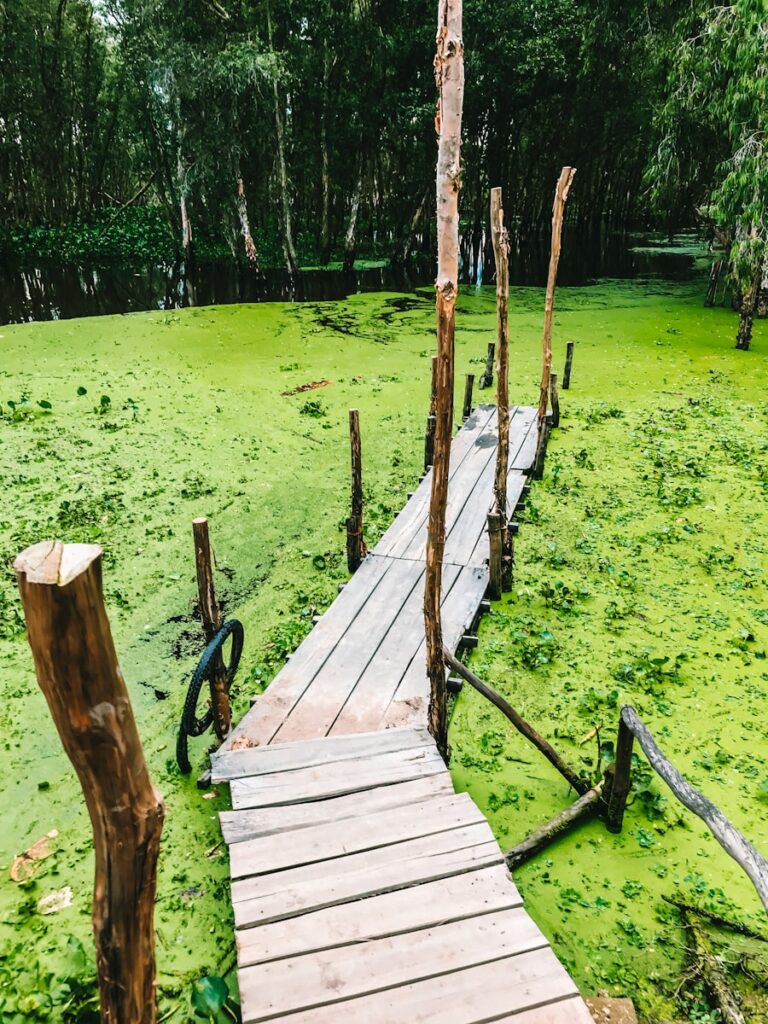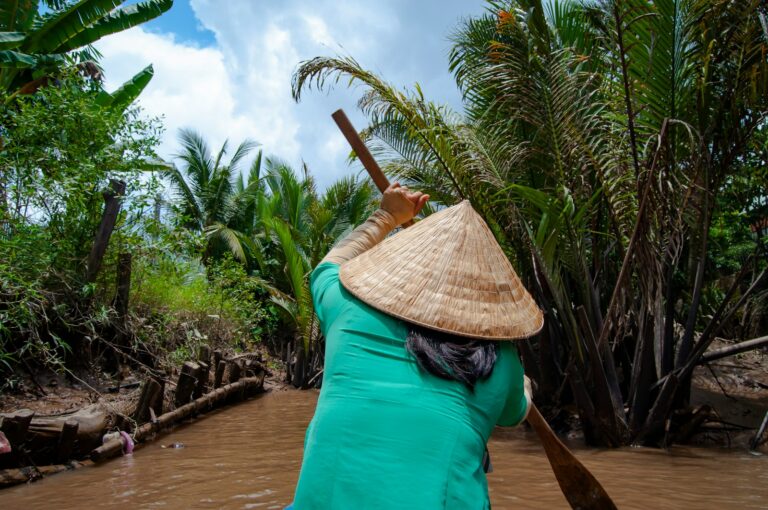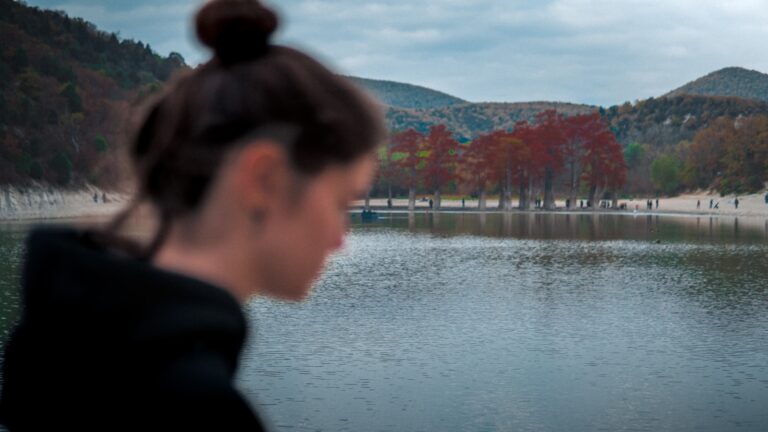Ca Mau: Vietnam’s Last Frontier at the Edge of Land and Sea
By Ngoc Tran
CA MAU, Vietnam— Some destinations leave their mark not through grand monuments or luxury comforts, but by offering something far rarer: authenticity. Vietnam’s southernmost province, Ca Mau, is one such place—a landscape where water swallows land, where nature still dictates the rhythms of life, and where every sunrise feels like a small miracle.
Far from the polished streets of Hanoi or the booming energy of Ho Chi Minh City, Ca Mau remains a world apart: raw, beautiful, and, for now, untouched by mass tourism. But for how much longer?

A World Adrift: Arriving Where Vietnam Ends
The journey itself feels like a step back in time. A small propeller plane ferried me from Ho Chi Minh City, skimming over endless rice fields, muddy rivers, and checkerboards of emerald green before touching down at Ca Mau’s modest airport. The air was thick with humidity, the smell of salt and earth clinging to every breath.
What awaited was a world where roads give way to rivers, where forests float on waterlogged soil, and where the Mekong River, after its 2,700-mile journey from Tibet, finally surrenders to the sea. I had arrived at Vietnam’s farthest edge—the very tip of the land, where the country dissolves into delta and mangrove.
The Forest That Walks on Water
My first stop was U Minh Ha National Park, often called Vietnam’s “Amazon.” Here, boats—not cars—are the preferred mode of transport. Our longtail boat slipped through narrow waterways stained tea-brown by tannins, the air alive with the buzz of cicadas and the calls of distant birds.
Mr. Tu, my guide, was a former honey hunter with hands rough as bark and eyes that glinted with humor. “The forest walks on water,” he told me, steering past floating vines and submerged roots. Beneath the surface, invisible fires smolder within ancient peat—sometimes for years without ever breaking through. Locals call it the dragon’s breath.
Deep within the park, stilt houses belonging to Vietnam’s Khmer minority hover above the floodwaters, their lives interwoven with the land’s shifting moods. At a small cooperative, I sampled wild forest honey—floral, smoky, tinged with herbs gathered from this watery wilderness. It tasted, I thought, like something ancient.
Mui Ca Mau: The Last Tip of Land
Further south, I reached Mui Ca Mau National Park, the symbolic “end of Vietnam.” A 28-meter observation tower juts above the mangroves, offering sweeping views over the place where the South China Sea and the Gulf of Thailand meet in an eternal tug-of-war.
This is land that moves. Literally. Sediment carried from the Mekong’s faraway headwaters causes the cape to shift southward by roughly 80 meters each year. The ground beneath your feet today may not exist in a decade.
Few tourists venture beyond the tower, but I followed a forgotten trail leading to the skeletal remains of a U.S.-era radar station, its rusted equipment now home to colonies of giant bats. As the sun sank into the sea, fishing boats dotted the horizon, their tiny lights winking like floating cities. The breeze off the water carried the scent of salt and woodsmoke, and I stood still, feeling the quiet pull of time.
Markets That Float and Breathe
Life in Ca Mau revolves around water. While tourists crowd the floating markets of Can Tho, the small, unassuming markets of Nam Can and Cai Con offer a glimpse of delta life unvarnished.
I arrived before dawn, as the sky blushed pale pink. Boats teemed with fresh crabs, glistening fish, and piles of spiny fruit. Women in conical hats balanced gracefully on the edges of their wooden vessels, sipping iced coffee while conducting business with quick, practiced hands. The scene felt both timeless and fragile, the kind of place that could vanish without fanfare as modernity creeps in.
I tried banh canh cua which is a peppery crab noodle soup that warmed the bones—and nibbled on crunchy water vegetables that grow only where fresh and salt water mingle. The market pulsed with energy, but by mid-morning, it had faded away, the boats dispersing like birds in flight.
Hon Khoai Island: Secrets of the Sea
One of the region’s best-kept secrets lies an hour offshore: Hon Khoai Island. The speedboat ride was smooth, the sea calm under a sky streaked with soft white clouds. As the island came into view, sheer granite cliffs rose from the water, their gray bulk softened by windswept greenery.
Used by the French as a prison for political exiles, Hon Khoai carries the weight of history. The old cell blocks, crumbling but defiant, still bear the scratched poetry of men who carved their hopes and sorrows into stone.
At twilight, I discovered a hidden lagoon accessible only during low tide. The water there shimmered faintly blue—bioluminescent plankton lighting the surface in a glow that felt otherworldly. Locals speak of the “Widow’s Current,” a dangerous undertow that has claimed many lives. Along the rocky shore, offerings of betel nut and rice are left to appease the sea.
Tastes of the Land, Forged by Water
Nowhere is Ca Mau’s wild character more evident than in its cuisine. At Quan Ut Trang, a floating eatery in Dam Doi district, Chef Mai greeted me with the kind of warmth that makes strangers feel like family. “Everything tastes different here,” she told me, “because everything is touched by the sea.”
She served me dishes both humble and extraordinary: shrimp raised in mangrove-fed waters, field mouse grilled with lemongrass, and delicate rice dumplings stuffed with sea worms. There was bee wine too—honey fermented with forest herbs and live larvae. Unusual, yes, but unforgettable.
Every bite told a story of survival and adaptation, of people living in harmony with an environment both generous and unforgiving.
Racing Against Time: A Vanishing Landscape
But all is not well in Ca Mau. The province is on the frontlines of climate change, its very existence threatened by rising seas and saltwater intrusion. At the Ngoc Hien Mangrove Research Station, Dr. Nguyen pointed out “ghost forests” where once-verdant trees stood lifeless, their roots poisoned by creeping tides.
Ca Mau loses approximately three meters of coastline each year—a slow, relentless erosion that no seawall can fully prevent. And yet, the human spirit here remains undeterred. Local communities are experimenting with floating rice varieties, sustainable shrimp-mangrove farming, and bamboo breakwaters that soften the sea’s advance.
At Mam Xanh Cooperative, I met women who now earn a living through eco-friendly aquaculture, their products fetching premium prices in global markets. They are not just saving their land—they are shaping a future where nature and economy can coexist.
The End—and the Beginning
As my plane lifted off from Ca Mau’s tiny airstrip, the rivers and forests below shimmered in the haze, silver and green, endless and fragile. I pressed my face to the window, reluctant to say goodbye.
Ca Mau is not an easy place. The heat is punishing, the roads rough, the comfort basic. But for those willing to look beyond the surface, it offers something truly rare: a glimpse of the world as it once was—wild, untamed, and heartbreakingly beautiful.
And with every tide, every whispered wind, every shift of the soil beneath your feet, you understand: this is a place where the story is still being written.




